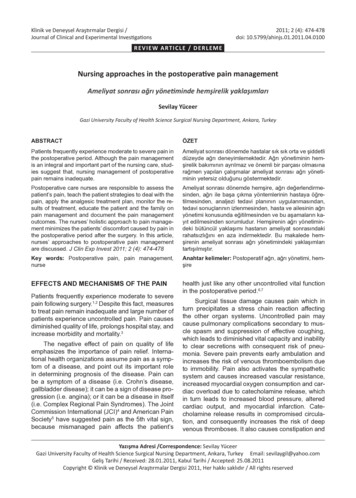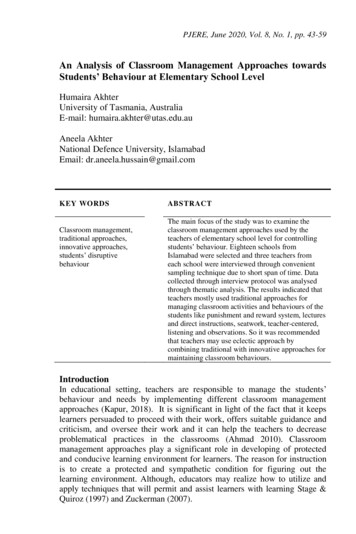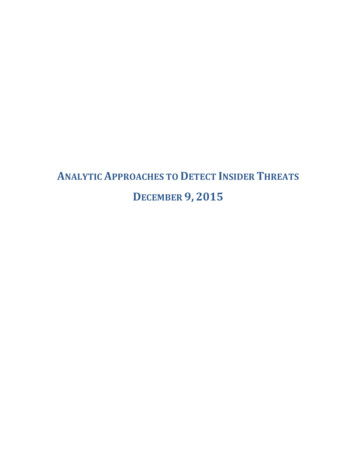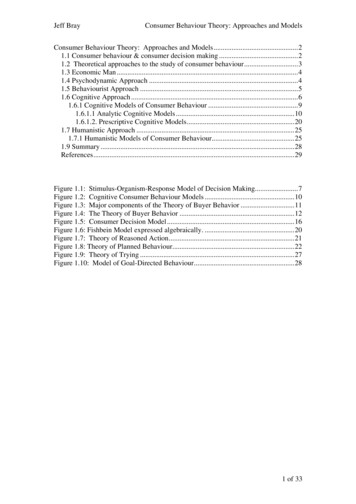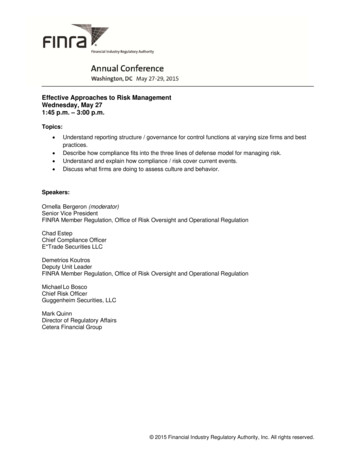
Transcription
Effective Approaches to Risk ManagementWednesday, May 271:45 p.m. – 3:00 p.m.Topics: Understand reporting structure / governance for control functions at varying size firms and bestpractices.Describe how compliance fits into the three lines of defense model for managing risk.Understand and explain how compliance / risk cover current events.Discuss what firms are doing to assess culture and behavior.Speakers:Ornella Bergeron (moderator)Senior Vice PresidentFINRA Member Regulation, Office of Risk Oversight and Operational RegulationChad EstepChief Compliance OfficerE*Trade Securities LLCDemetrios KoutrosDeputy Unit LeaderFINRA Member Regulation, Office of Risk Oversight and Operational RegulationMichael Lo BoscoChief Risk OfficerGuggenheim Securities, LLCMark QuinnDirector of Regulatory AffairsCetera Financial Group 2015 Financial Industry Regulatory Authority, Inc. All rights reserved.
A REPORT FROM THEFINANCIAL INDUSTRY REGULATORY AUTHORITYReport on Conflicts of InterestOCTOBER 2013EXECUTIVE SUMMARYConflicts of interest can arise in any relationship where a duty of care ortrust exists between two or more parties, and, as a result, are widespreadacross the financial services industry. While the existence of a conflict doesnot, per se, imply that harm to one party’s interests will occur, the history offinance is replete with examples of situations where financial institutionsdid not manage conflicts of interest fairly. Indeed, many of the foundationalpieces of legislation governing financial services in the United Statescontain provisions crafted precisely to address conflict situations.1ContentsEnterprise-Level ConflictsGovernance Framework5New Business and New ProductConflicts Review18Compensation and Oversight26Appendix I – Conflicts Regulationin the United States and SelectedInternational Jurisdictions37Appendix II – Text of FINRALetter to Firms AnnouncingConflicts Review40Appendix III – Summary ofConflicts Identified by Firms41Endnotes43This report focuses solely on broker-dealers, the entities the FinancialIndustry Regulatory Authority (FINRA) regulates. Broker-dealers aresubject to comprehensive regulation under the federal securities laws,Securities and Exchange Commission (SEC) rules and FINRA rules.2 Conflictsof interest are an SEC and FINRA priority and have been addressedthrough rulemaking, oversight and enforcement action.3 (See Appendix Ifor a non-exhaustive list of conflicts-related rules.)This report carries those efforts forward. It recognizes that many brokerdealer firms have made progress in improving their conflicts managementpractices, but emphasizes that firms should do more to manage andmitigate conflicts of interest in their businesses.To assist in these efforts, FINRA launched its conflicts initiative in July 20124to review firms’ approaches to conflicts management and to identifyeffective practices.5 We used firms’ responses to FINRA’s conflicts reviewletter, in-person meetings and a follow-up compensation questionnaireto develop the observations detailed in this report.The report is not intended as an inventory of conflicts that firms face,nor does it cover many conflicts that federal securities laws and SECand FINRA rules already address, such as investment banking-researchseparation, outside business activities, soft dollars, payment for orderflow or securities allocations to customers. Instead, FINRA’s objective is tofocus on firms’ approaches to identifying and managing conflicts in threecritical areas—firms’:1 enterprise-level frameworks to identify and manage conflicts of interest; approaches to handling conflicts of interest in manufacturing anddistributing new financial products; and approaches to compensating their associated persons, particularlythose acting as brokers for private clients. REPORT ON CONFLICTS OF INTEREST—OCTOBER 2013
The enterprise-level framework discussion examines how firms address conflicts across their businesslines from a top-down perspective. The new product and new business discussion explores how firmsaddress conflicts related to the introduction of new products and services. Together, these areas playcritical “gatekeeper” roles. Specifically, if firms are effective with enterprise-level frameworks andhandling conflicts with new products, they can be proactive in identifying and managing conflicts. Thefocus on compensation provides insight on financial incentive structures that may create, magnify ormitigate conflicts of interest.The report identifies effective practices that FINRA observed at firms or that, based on experience andanalysis, FINRA believes could help firms improve their conflicts management practices. It also containsmore general observations and commentary on firms’ practices that we share for the industry’sinformation. FINRA recognizes that the effective practices and observations in this report are drawnfrom discussions with large firms and, as a result, will not in all cases be directly applicable to smallfirms.This report is a point-in-time review of several facets of conflicts of interest. Given conflicts’pervasiveness and potential to cause customer harm, FINRA will continue to assess firms’ conflictsmanagement practices and the effectiveness of those practices in protecting customers’ interests.FINRA will also monitor the effectiveness of approaches to conflicts regulation used internationally.FINRA expects firms to consider the practices presented in this report, and to implement a strongconflict management framework. If firms do not make adequate progress on conflicts management,FINRA will evaluate whether rulemaking to require reasonable policies to identify, manage and mitigateconflicts would enhance investor protection.FINRA stresses that this report is not intended to express any legal position, and does not create anynew legal requirements or change any existing regulatory obligations. Throughout the report, weidentify conflicts management practices that we believe firms should consider and tailor to theirbusiness model as they strengthen their own conflicts frameworks.Conflicts of Interest FrameworkThe first focus of this report is firms’ enterprise-level conflicts of interest frameworks. We use theterm framework to mean the combination of underlying ethics culture, organizational structures,policies, processes and incentive structures that, in their totality, shape a firm’s management ofconflicts of interest.An effective practice is for firms to implement an articulated, firm-wide framework to manageconflicts of interest, and FINRA observed a number of firms that implemented many facets ofsuch a framework. The key to making such a framework effective begins with the tone from thetop. To be effective, firm leadership should require not only adherence to the letter of the law,but a commitment to the highest ethical standards and to putting customers’ interests first. Ofcourse, reliance on the tone from the top to address conflicts of interest is insufficient by itself.As appropriate to the scale and complexity of a firm’s business, elements of an effective practiceframework for managing conflicts of interest include: 2 defining conflicts of interest in a way that is relevant to a firm’s business and which helpsstaff identify conflict situations; articulating employees’ roles and responsibilities with respect to identifying and managingconflicts; establishing mechanisms to identify conflicts in a firm’s business as it evolves;REPORT ON CONFLICTS OF INTEREST—OCTOBER 2013
defining escalation procedures for conflicts of interest within and across business lines; avoiding severe conflicts, even if that avoidance means foregoing an otherwise attractivebusiness opportunity; disclosing conflicts of interest to clients, taking into consideration the different needs ofretail and institutional clients; training staff to identify and manage conflicts in accordance with firm policies andprocedures; and reporting on significant conflicts issues, including on a firm’s own measures to identifyand manage conflicts, to the Chief Executive Officer (CEO) and board.New Product ConflictsThe second focus of this report is the introduction of new financial products. Firms at the forefrontof financial innovation are in the best position, and are uniquely obligated, to identify the conflictsof interest that may exist at a product’s inception or that develop over time.There are a number of effective practices firms can adopt to address such conflicts. First, firmscan use a new product review process—typically through new product review committees—thatincludes a mandate to identify and mitigate conflicts that a product may present.Second, firms should disclose those conflicts in plain English, with the objective of helpingensure that customers comprehend the conflicts that a firm or registered representative havein recommending a product.6 These conflicts may be particularly acute where complex financialproducts are sold to less knowledgeable investors, including retail investors.7Third, product manufacturing firms can implement effective Know-Your-Distributor (KYD) policiesand procedures. These KYD measures help mitigate the incentive to increase revenue from productsales by using distribution channels that may not have adequate controls to protect customers’interests.Fourth, firms can perform post-launch reviews of new products to identify potential problems witha product that may not have been readily apparent during the initial review—or that may havearisen as a result of economic events—and take remedial action.Fifth, firms can carefully evaluate and decline to offer products to customers when the conflictsassociated with those products are too significant to be mitigated effectively.To reduce conflicts, firms’ private wealth businesses should operate with appropriateindependence from other business lines within a firm. FINRA is encouraged by firms’ generaladoption of open product architectures (i.e., the sale of third party in addition to proprietaryproducts). Nonetheless, firms involved in both the manufacture and distribution of products shouldmaintain effective safeguards to alleviate pressure to prefer proprietary products to the detrimentof customers’ interests. This is particularly important as firms seek to leverage their brokerage andother platforms to cross-sell products and services. Equally important, firms with revenue sharingor other partnering arrangements with third parties should exercise the necessary diligence andindependent judgment to protect their customers’ interests. 3 REPORT ON CONFLICTS OF INTEREST—OCTOBER 2013
Compensation PracticesThe final focus of this report is compensation. Although the primary focus is on brokeragecompensation (and related supervisory and surveillance systems), the report also addresses theapplication of tools to mitigate conflicts of interest in compensation for associated persons moregenerally. Many firms have considered and taken steps to mitigate these conflicts directly throughchanges to compensation arrangements and through supervision of registered representatives’sales activities.The use of “product agnostic” compensation grids (also referred to as “neutral grids”) can be aneffective practice to reduce incentives for registered representatives to prefer one type of product(e.g., equities, bonds, mutual funds, variable annuities) over another.8 These grids typically paya flat percentage of the revenue a registered representative generates, regardless of productrecommended. FINRA notes, however, that while this eliminates one variable that may influencerecommendations, registered representatives still have an incentive to favor products with highercommissions because these produce larger payouts. Consequently, to reduce conflicts, firms shouldtake measures to mitigate biases that differences in compensation by product may create.Another effective practice is for firms to link surveillance of registered representatives’recommendations to thresholds in a firm’s compensation structure to detect recommendations,or potential churning practices, that may be motivated by a desire to move up in the compensationstructure and, thereby, receive a higher payout percentage.Enhancing supervision and surveillance of a registered representative’s recommendations as thatperson approaches other significant compensation or recognition milestones is a related effectivepractice. A number of firms perform specialized supervision and surveillance of recommendationsas a registered representative approaches the end of the period over which performance ismeasured for receiving a back-end bonus. In addition, some firms perform additional surveillanceto assess the suitability of recommendations as a registered representative approaches thethreshold necessary for admission to a firm recognition club (e.g., a President’s Club or similar).An effective practice is enhancing supervision and surveillance of a registered representative’srecommendations around key liquidity events in an investor’s lifecycle, such as the point wherean investor rolls over her 401(k). The recommendations a representative makes at this stage ofan investor’s life have profound implications for the investor and deserve thorough scrutinyand review.Another effective practice is for firms to reduce the incentive for a registered representative toprefer one mutual fund or variable annuity family over another by capping the credit a registeredrepresentative may receive for a comparable product across providers. For example, differentmutual fund families might offer gross dealer concessions (GDC) of 5, 4 and 3.5 percent on acomparable fund. Some firms cap the GDC for that particular type of fund at 4 percent, whichreduces the incentive for the registered representative to recommend the fund that pays a 5percent GDC to enhance his compensation. FINRA observed several firms that implement thispractice.Finally, imposing compensation adjustments on registered representatives who do not properlymanage conflicts of interest is an effective practice.Questions/Further InformationInquiries regarding the Report may be directed to Daniel M. Sibears, Executive Vice President,Regulatory Operations/Shared Services, at (202) 728-6911; George Walz, Vice President, RegulatoryPrograms/Shared Services, at (202) 728-8462, or Steven Polansky, Senior Director, RegulatoryPrograms/Shared Services, at (202) 728-8331. 4 REPORT ON CONFLICTS OF INTEREST—OCTOBER 2013
ENTERPRISE-LEVEL CONFLICTS GOVERNANCE FRAMEWORKIntroductionVirtually every financial firm, including those regulated by FINRA, faces potential conflicts ofinterest in its business. In order to address those conflicts, a firm should be able to recognizeconflict situations and take measures to manage them appropriately. Firms should addressconflicts through proactive decision making, not ad hoc responses to conflicts-related events.The framework for this proactive decision making depends on the scope and scale of a firm’sbusiness.9 It will look vastly different for a small introducing broker than for a large firm withmultiple affiliates engaged in a broad range of businesses on a national or global scale.Large firms may address conflicts of interest through their enterprise risk management oroperational risk frameworks. Components of such programs, such as risk and control selfassessments, may provide an opportunity to identify conflicts of interest within a firm’s businessand evaluate their possible impacts. Efforts to quantify those impacts might still be in their earlystages, but as operational risk techniques advance, these efforts may provide firms with additionaltools to help focus their conflicts of interest management efforts.By contrast, the conflicts management framework at a small firm selling basic products mightrely largely on the ethical tone set by the firm owner coupled with required supervisory controls,especially those related to suitability, and the firm’s compensation structure.Although conflicts management frameworks may differ among firms, small and large firms alikeoften face some of the same basic conflicts. For example, a firm or its registered representativesmay have an incentive to recommend one product over another. Conflicts may exist betweenan associated person’s activities as a broker and their outside business activities. Firms may betempted to hire an associated person in spite of a poor regulatory history, if they believe that theindividual can boost firm profitability.Effective Practices Summary: Comprehensive Conflicts Governance FrameworkAn effective practice FINRA observed at a number of firms is implementation of acomprehensive framework to identify and manage conflicts of interest across and withinfirms’ business lines that is scaled to the size and complexity of their business. Without sucha framework, firms are more likely to experience situations where conflicts cause harm tocustomers or the firm. Key features of a robust conflicts management framework that wereobserved include: a “tone from the top” that emphasizes the importance of ethical treatment ofcustomers and the fair handling of conflicts of interest;articulated structures, policies and processes to identify and manage conflicts ofinterest that include: a working description of conflicts of interest that enables employees to understandand identify conflicts of interest that may arise in a firm’s business;adoption of a best interests of the customer standard in a firm’s code of conduct;a delineation of employees’ responsibilities with respect to identifying andmanaging conflicts of interest;defined escalation procedures for handling potential conflict situations;continued 5 REPORT ON CONFLICTS OF INTEREST—OCTOBER 2013
proactive and systematic identification of conflicts of interest in a firm’s businesson an ongoing and periodic basis; transparency of material conflicts to executive management and the board; andperiodic testing of the firm’s conflicts management framework; a willingness to avoid severe conflicts, even if that avoidance means foregoing anotherwise attractive business opportunity;effective disclosure to clients, taking into consideration the different needs of retailand institutional clients;hiring practices that rigorously review potential employees’ ethical, financial andregulatory history;training that focuses on ethical treatment of customers and enables staff to identifyand manage conflicts; andan information technology infrastructure that supports conflicts management in acomprehensive manner.“Tone from the Top,” Firm Culture and Conflicts of InterestAn effective practice for all firms is the establishment of a “tone from the top” that stresses theimportance of ethical decision making and fair treatment of customers. This tone is set by a firm’sexecutive management in their day-to-day actions and decisions. It is incumbent upon them toconsistently communicate and demonstrate the values to which they expect their employees toadhere, and to monitor employees’ behavior to ensure that it aligns with the firm’s stated values.Without the proper tone from the top, many of the measures discussed later in this report willbe ineffective. Leadership that singlemindedly drives the distribution of proprietary productsmay undermine the effectiveness of new product review processes intended to protect customerinterests. Conflict management frameworks cannot be expected to succeed without the strongsupport of a firm’s leaders.Boards can play an important role in setting the tone from the top. Providing the board withvisibility on significant conflicts a firm faces, as well as the firm’s overall approach to conflictsmanagement, signals the importance the highest levels of the firm attach to addressing conflictsissues. Several firms report on conflicts issues to their boards, sometimes within the context ofthe firm’s risk management reporting.It is important to note, though,
to review firms’ approaches to conflicts management and to identify effective practices.5 We used firms’ responses to FINRA’s conflicts review letter, in-person meetings and a follow-up compensation questionnaire to develop the observations detailed in this report. The report is n

